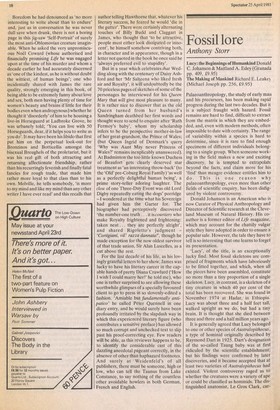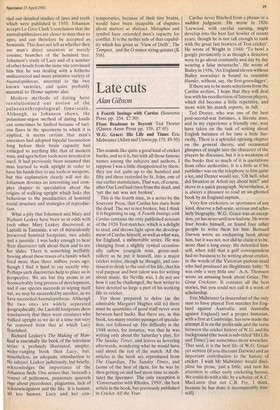Fossil lore
Anthony Storr
Lucy: the Beginnings of Humankind Donald C. Johanson & Maitland A. Edey (Granada pp. 409, £9.95) The Making of Mankind Richard E. Leakey (Michael Joseph pp. 256, £9.95) Palaeoanthropology, the study of early man and his precursors, has been making rapid progress during the last two decades. But it is a subject fraught with hazard. Fossil remains are hard to find, difficult to extract from the matrix in which they are embed, ded, and, even with modern methods, often impossible to date with certainty. The range of variability within a species is hard to determine, since it is rare to find enough specimens of different individuals belong ing to a single group. When someone working in the field makes a new and exciting discovery, he is tempted to extrapolate beyond the facts, and claim more for his 'find' than meagre evidence entitles him to do. This is one reason why palaeoanthropology, even more than other fields of scientific enquiry, has been disfigured by violent controversy.
Donald Johanson is an American who is now Curator of Physical Anthropology and Director of Scientific research at the Cleve land Museum of Natural History, His coauthor is a former editor of Life magazine, which may account for the chattily vulgar style they have adopted in order to ensure a popular sale. However, the tale they have to tell is so interesting that one learns to forget its presentation.
'Lucy', of the title, is an exceptionally lucky find. Most fossil skeletons are com prised of fragments which have laboriously to be fitted together, and which, when all the pieces have been assembled, constitute no more than a tiny proportion of a single skeleton. Lucy, in contrast, is a skeleton of a tiny creature in which 40 per cent of the total has been recovered. She was found in November 1974 at Hadar, in Ethiopia. Lucy was about three and a half feet tall, walked upright as we do, but had a tiny brain. It is thought that she died between three and three and a half million years ago. It is generally agreed that Lucy belonged to one or other species of Australopithecus, a type of hominid originally described by Raymond Dart in 1925. Dart's designation of the so-called Taung baby was at first ridiculed by the scientific establishment; but his findings were confirmed by later discoveries, and it became accepted that at least two varieties of Australopithecus had existed. Violent controversy raged as to whether the creatures were a variety of ape or could be classified as hominids. The distinguished anatomist, Le Gros Clark, car ried out detailed studies of jaws and teeth which were published in 1950. Johanson accepts Le Gros Clark's conclusion that the australopithecines are closer to man than to apes, and can therefore be accepted as hominids. This does not tell us whether they are man's direct ancestors or merely cousins; branches of the hominid tree. Johanson's study of Lucy and of a number of other fossils from the same site convinced him that he was dealing with a hitherto undiscovered and more primitive variety of Australopithecus, ancestral to the two known varieties, and quite probably ancestral to Homo sapiens also.
Modern methods of dating have revolutionised our notion of the palaeoanthropological time-scale. Although, as Johanson shows, the potassium-argon method of dating fossils can sometimes be faulted because of various flaws in the specimens to which it is applied, it seems certain that man's ancestors had adopted bipedal locomotion long before their brain capacity had enlarged to anything like that of modern man, and ages before tools were invented or used. It had previously been assumed that man learned to walk upright in order to have his hands free to use tools or weapons, but this explanation clearly will not do. Johanson devotes an interesting and complex chapter to speculation about the origins of walking upright which links this behaviour to the peculiarities of hominid social structure and strategies of reproduction.
What a pity that Johanson and Mary and Richard Leakey have been so at odds with each other. Mary Leakey discovered, at Laetolil in Tanzania, a set of miraculously preserved hominid footprints, two adults and a juvenile. I was lucky enough to hear their discoverer talk about them and to see her slides. There is something ineffably moving about these traces of a family which lived more than three million years ago, though I find it hard to say exactly why. Perhaps such discoveries help to place us in Perspective, We are but tiny atoms in an inconceivably long process of development, and if our species succeeds in wiping itself out, we may be succeeded by another, as we have succeededAustralopithecus. Although the two sites are • widely separated geographically, the Laetolil footprints show conclusively that there were creatures who walked upright as we do at a time not very far removed from that at which Lucy flourished.
Richard Leakey's The Making of Mankind is essentially the book of the television series: a profusely illustrated, simpler, Wider-ranging book than Lucy, but, nonetheless, an adequate introduction to the subject. Leakey judiciously, but briefly, acknowledges the importance of the Johanson finds. One senses that, beneath a veneer of politeness, passionate quarrels rage about precedence, plagiarism, lack of acknowledgment and the like. It is human, all too human. Lucy and her con temporaries, because of their tiny brains, would have been incapable of disputes about matters so abstract. Metaphor and symbol have extended man's capacity for conflict. It is the nether side of that capability which has given us 'View of Delft', The Tempest, and the G minor string quintet (K 516).



































 Previous page
Previous page